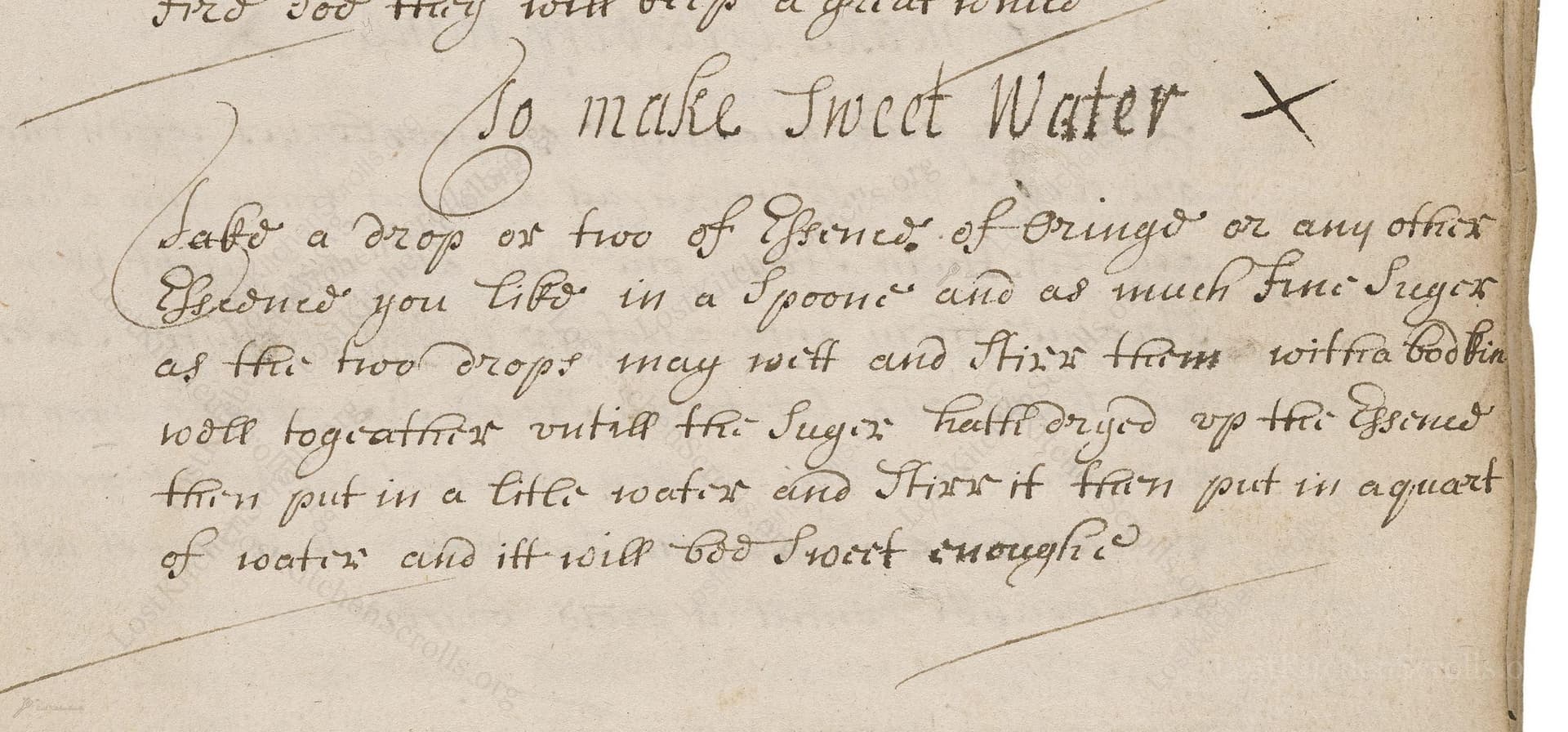So Make Sweet Water
From the treasured pages of Cookery book of Ann Goodenough
Written by Ann Goodenough

So Make Sweet Water
"Take a drop or two of Spices or Oringd or any other Essences you Like in a spoon and as much fine Sugar as the two drops may well and Stire them with a bodkin well togeather untill the Sugar hath dryed up the Essenced then put in a litle water and Stir it then put in a quart of water and itt will be Sweet enough?"
Note on the Original Text
Written in the informal instructional style of 18th-century manuscript cookery, the recipe relies on minimal measurements ('a drop or two,' 'as much...as the two drops may well') and assumes the cook's familiarity with basic technique. Odd spellings—'Oringd' for 'orange,' 'Stire' for 'stir,' and 'tole' for 'together'—are characteristic of the era before spelling was standardized. The use of dashes, colons, and unconventional punctuation reflects a conversational, almost oral, approach to recipe sharing: more guidance than prescription, with plenty of room for personal adaptation.

Title
Cookery book of Ann Goodenough (1738)
You can also click the book image above to peruse the original tome
Writer
Ann Goodenough
Era
1738
Publisher
Unknown
Background
A delightful journey into the kitchens of early 18th-century England, this collection captures the flair and flavors of its time with recipes crafted by the inventive Ann Goodenough. Expect a charming medley of hearty roasts, comforting pies, and time-honored confections, perfect for those wishing to dine as they did in Georgian days.
Kindly made available by
Folger Shakespeare Library
This recipe comes from Ann Goodenough, an Englishwoman living in the 18th century, between 1700–1775. During this period, 'sweet waters' were fashionable homemade cordials or aromatic drinks, often served to guests or used medicinally. At a time before commercial soft drinks or artificial flavors, such recipes enabled creative use of imported spices, essences, or fruit waters. This charmingly simple recipe reflects the rising interest in delicate flavors and the social practice of home entertaining or genteel refreshment. Essences like orange flower or rosewater were luxury imports, signaling wealth and sophistication. Recipes such as this one appear in family receipt (recipe) books, often passed down through generations.

The recipe would have been prepared using a simple kitchen spoon, finely milled sugar, and a 'bodkin'—a pointed, needle-like tool (traditionally used for sewing, but pressed into duty here for mixing). Stoneware or glass jugs would have held the sweet water, with mixing either done in a spoon or a small bowl before transferring to a larger container. No specialized equipment was needed beyond what any modest Georgian household would possess.
Prep Time
5 mins
Cook Time
0 mins
Servings
4
We've done our best to adapt this historical recipe for modern kitchens, but some details may still need refinement. We warmly welcome feedback from fellow cooks and culinary historians — your insights support the entire community!
Ingredients
- 2 drops orange (or other spice) essence (modern: food-grade orange blossom water, rosewater, or similar essence)
- 1 teaspoon fine white sugar
- 1 tablespoon water (to start mixture)
- 1 quart cold water
Instructions
- To make a batch of Sweet Water, place 2 drops of orange or other spice essence into a tablespoon.
- Add about 1 teaspoon (roughly 4 grams) of fine white sugar.
- Mix thoroughly with a slender tool (a skewer or the tip of a knife) until the sugar is fully infused and has absorbed most of the essence.
- Add a small splash of water (about 1 tablespoon/0.5 fl oz) to dissolve the mixture, stirring until smooth.
- Finally, pour in 1 quart (about 4 cups/32 fl oz) of cold water, mix well, and taste for sweetness or fragrance.
- Adjust with a splash more essence or sugar if you like.
- Serve chilled, over ice, or at room temperature as a fragrant, subtle refreshment.
Estimated Calories
16 per serving
Cooking Estimates
This recipe takes just a few minutes to mix the sugar, essence, and water together. There is no cooking involved. Each serving is low in calories since it mostly consists of flavored water and a small amount of sugar.
As noted above, we have made our best effort to translate and adapt this historical recipe for modern kitchens, taking into account ingredients nowadays, cooking techniques, measurements, and so on. However, historical recipes often contain assumptions that require interpretation.
We'd love for anyone to help improve these adaptations. Community contributions are highly welcome. If you have suggestions, corrections, or cooking tips based on your experience with this recipe, please share them below.
Join the Discussion
Rate This Recipe
Dietary Preference
Main Ingredients
Culinary Technique
Occasions

Den Bockfisch In Einer Fleisch Suppen Zu Kochen
This recipe hails from a German manuscript cookbook compiled in 1696, a time whe...

Die Grieß Nudlen Zumachen
This recipe comes from a rather mysterious manuscript cookbook, penned anonymous...

Ein Boudain
This recipe comes from an anonymous German-language manuscript cookbook from 169...

Ein Gesaltzen Citroni
This recipe, dating from 1696, comes from an extensive anonymous German cookbook...
Browse our complete collection of time-honored recipes



